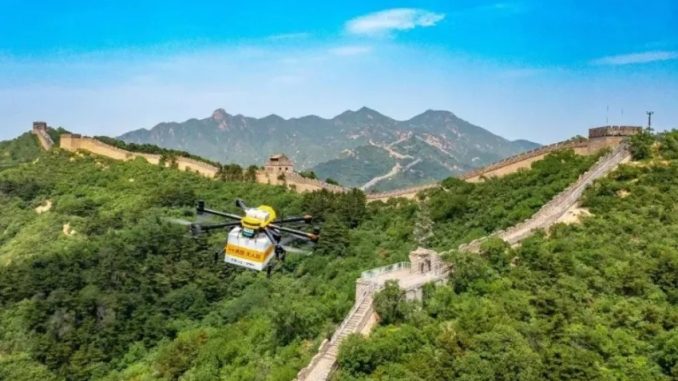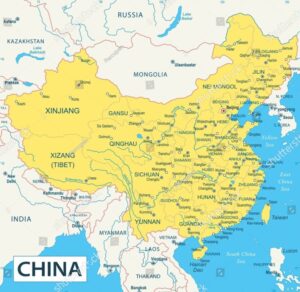
China‘s low-altitude economy is advancing from policy to pilot projects, with key provinces deploying drones for logistics, infrastructure inspection, and traffic management. Despite challenges like airspace and infrastructure, the sector shows strong growth potential for scalable applications.
In 2024, low-altitude economy policies were intensively released in China, with both national and local governments introducing specific policies to promote this emerging industry. 2025 is considered the first year of substantial development for the low-altitude economy, driving the entire industry into a phase of practical exploration.
Currently, the development of low-altitude traffic is transforming from macro blueprints into pilot practices across various regions. Many areas in China are actively conducting pilot demonstrations, scenario construction, and commercial validation. In 2025, the Ministry of Transport of China released 21 highway inspection pilot projects, addressing the pain points of traditional highway patrols such as “inaccessible mountainous areas, cross-sea blind spots, low manual efficiency, and high risks.” These projects also pave the way for the compliant application and standard-setting of low-altitude aircraft in the field of transportation infrastructure.
The development plan for public security traffic management will also comprehensively broaden the application of new technologies and equipment such as artificial intelligence, large models, block chain, drones, autonomous transport vehicles, and robots. It will focus on key business reforms and improvements in traffic safety prevention and control, urban smart traffic management, and scientific law enforcement services in traffic control, comprehensively broadening the application of new technologies and equipment such as artificial intelligence, large models, block chain, drones, autonomous transport vehicles, and robots, and focusing on key business reforms and improvements in traffic safety prevention and control, urban smart traffic management, and scientific law enforcement services in traffic control.
Although low-altitude traffic shows good development momentum, the industry is still in its early stages, the overall ecosystem is not yet mature, and it faces challenges in various aspects. Current factors restricting the development of low-altitude traffic include airspace restrictions, insufficient infrastructure, and lack of user awareness.

(Image:Shutterstock)
Low-Altitude Traffic Application Scenarios and Key Projects by Province
Low-altitude traffic is no longer just an idea; it is accelerating its implementation across the country at a remarkable speed. This application practice focused on the low-altitude field is reshaping the traditional traffic landscape. Here are the planned application scenarios for low-altitude traffic by province.
Zhejiang: Comprehensive coverage with clearly defined scenarios
As the province with the most extensive application within the province, Zhejiang implements drone application scenarios in a refined manner based on “city + county” units, with different cities having their own focuses.
Hangzhou: Focuses on urban maintenance and specific logistics needs. The core is “UAV + urban services,” such as smart inspection for subway protection, automatic inspection of high-rise buildings, and other urban safety operation and maintenance scenarios. It also implements precise logistics scenarios like Yunyaun UAV express delivery and trunk line takeaway logistics, balancing safety and efficiency.
Wenzhou: Features comprehensive scenario coverage, forming a three-dimensional layout of “transportation infrastructure inspection + low-altitude logistics + air traffic.” The infrastructure end focuses on road, slope, and key structure inspections. The logistics end covers instant takeaway, medical supplies, agricultural products, and other multi-category low-altitude deliveries. It also explores short-distance/intercity air traffic, building a low-altitude three-dimensional traffic network.
Taizhou: Focuses on “regional linked logistics,” combining coastal and municipal characteristics to implement cross-regional logistics scenarios such as land-island combined transport, airport shuttle, and direct Bay Area access. It also covers intra-city needs like agricultural product transportation and park logistics, while incorporating traffic law enforcement, forming a dual support of “logistics + supervision.”
Guangdong Province: Technological leadership, emphasizing multi-modal coordination and livelihood security
Guangdong is a “technology pioneer province” for drones and low-altitude applications, emphasizing “unmanned coordination + essential livelihood needs,” leading the nation in application depth and breadth.
Core Directions: Pioneered the “Land-Sea-Air-Underground” unmanned coordinated transport model, breaking single-scene limitations. In the livelihood sector, it focuses on medical supply transportation, forming a full-chain low-altitude delivery system from blood products, medical liquid reagents to rescue supplies, such as blood transport from Nanhai Blood Station and multi-scenario medical sample delivery.
Traffic Management End: Deeply participates in the full lifecycle management of highways, covering “construction-management-maintenance” from pre-construction work for roads, to expressway traffic management, daily maintenance detection, and special large bridge structure detection and high slope cruising. It also emphasizes road dynamic monitoring and emergency response, such as real-time road condition photography, rapid traffic accident handling, and capturing traffic violations, improving law enforcement efficiency.
Logistics + Travel Services: Builds a “low-altitude logistics distribution system,” covering intercity transport, last-mile delivery, and remote area supply. It also promotes the expansion of UAVs in agricultural supplies, customized business flights, short-distance passenger transport, forming a low-altitude logistics network combining “general + specialized” services.
Southwest Provinces (Sichuan, Chongqing, and Yunnan): Leveraging geographical features to solve regional traffic pain points
Southwest provinces (Sichuan, Chongqing, Yunnan) all face complex geographical environments like mountains, plateaus, and multiple water bodies. Construction focuses on “breaking topographical constraints, ensuring livelihoods and infrastructure safety.”
Sichuan: Focuses on “full-dimensional inspection of transportation infrastructure,” innovating with “UAV + AI identification” technology to achieve full coverage inspection of “protection areas – tracks – catenary – structures – equipment” for expressways, rail transit, and local railways. It also extends to three-dimensional inspection of river waterways and traffic dynamic monitoring. The logistics end focuses on “low-altitude + livelihoods,” implementing rural/mountainous/scenic area logistics, cross-city agricultural product transport, and instant delivery of medical supplies for multi-hospital systems, compensating for ground transportation shortcomings.
Chongqing Municipality: Creates a low-altitude transport network with “hubs + scenarios.” Using airports in Liangping, Yongchuan, Wanzhou, etc., as hubs, it implements branch line logistics, intercity logistics, and comprehensive transport scenarios. Combining mountain city characteristics, it conducts urban bridge and tunnel inspections, and “air-space-ground integrated” perception and control for expressways. The logistics end covers medical delivery (regular medicines, combat zone rescue medicines), urban instant delivery, and express delivery. It also innovates with heavy-lift UAV material transport and delivery, strengthening emergency support capabilities.
Yunnan: Focuses on solving material transport difficulties in border villages, mountainous areas, and plateaus, such as low-altitude transport of specialty agricultural products like Caoguo in Nujiang Prefecture and Songrong in Diqing Prefecture, rural logistics in Pingbian County, and the construction of a smart medical logistics network for county medical communities. The infrastructure end focuses on highway and waterway maintenance, achieving smart inspection of the expressway network and application in highway engineering construction supervision. It also implements rapid handling of UAV traffic accidents in Kunming City, balancing safety and livelihoods.
Northern Provinces (Shandong, Hebei, Heilongjiang, Jilin): Focusing on specific scenarios, strengthening regional adaptation
Northern provinces combine their own geographical (islands, cold) and demand characteristics, with application scenarios more focused on “breakthroughs in specific fields.”
Shandong: Addressing the characteristics of numerous coastal islands, it builds island low-altitude logistics and medical supply “air corridors” to solve island supply problems. It also conducts UAV maritime inspection and operations, as well as road inspection for expressways and national/provincial highways, forming a dual inspection system of “ocean + land,” while also covering livelihood scenarios like retail delivery and campus logistics.
Hebei: Taking the Xiongan New Area as the core pilot, it implements the China Telecom Smart City Industrial Park UAV logistics delivery scenario. It also builds a shared scenario for rural flight station logistics networks, focusing on exploring the model of “smart parks + rural supply,” precisely matching regional development needs.
Heilongjiang: Constrained by cold and geography, application scenarios are relatively concentrated, focusing on implementing short-distance transport at Huma General Aviation Airport, with “general aviation + short-distance shuttle” as the core, compensating for insufficient ground transport capacity in winter and focusing on basic transport needs.
Jilin: Forms a combined scenario of “traffic law enforcement + rail transit operation and maintenance + livelihood distribution.” The law enforcement end uses UAVs for traffic control and violation detection. The operation and maintenance end conducts rail transit inspection, railway and oil/gas pipeline inspection, and bridge/tunnel safety inspection. The logistics end combines local needs to implement express delivery, aquatic product logistics, and takeaway delivery, with scenarios balancing regulation and livelihoods, adapting to urban traffic operation and maintenance needs.
From the practices of these provinces, we can see that low-altitude traffic has broken through the limitations of traditional general aviation and is deeply integrating with various fields such as urban management, logistics and transportation, medical emergency services, agricultural services, and travel services, redefining our concepts of time and space and lifestyle.
Over the past year, a large number of public bidding projects have been launched in the national low-altitude traffic sector, with Zhejiang, Hebei, Chongqing, Hubei, and Guangxi ranking top nationally in terms of bidding amount. In terms of the amount per project, projects are mainly concentrated around 1 million RMB. The bidding units are mainly transportation bureaus of various provinces and cities and low-altitude industry development companies, while the winning units are relatively dispersed.
Introduction to low-altitude traffic application scenarios
The rise of low-altitude traffic brings new development prospects to the road traffic field. Currently, drones can be seen performing inspection tasks along expressways in many places, including road condition monitoring, violation identification, and rapid evidence collection for traffic accidents.
In contrast, urban roads are limited by complex road conditions, dense populations, and high-rise buildings, making UAV flight route planning difficult and facing higher safety requirements and regulatory pressure. Drones cannot comprehensively and accurately monitor traffic conditions in real-time. Therefore, in the field of urban road traffic, the application scenarios for drones are far less extensive than in the expressway field.
From a traffic management perspective, highways generally connect cities or cities and towns, with relatively simple road conditions. Using drones equipped with high-definition cameras allows for real-time monitoring of the entire line, promptly identifying road condition issues. Meanwhile, the application of drones on highways can leverage existing highway infrastructure, such as establishing UAV takeoff/landing points and maintenance points in service areas. In contrast, it is difficult to find suitable and concentrated supporting facilities around urban roads for large-scale UAV inspections.
Challenges facing low-altitude traffic applications
Although low-altitude traffic shows broad prospects amid market expectations, its development is still in the early exploratory stage. The core bottlenecks currently entitle breakthrough in the industry are mainly reflected in the following aspects:
Airspace restrictions
Currently, the biggest pain point in airspace use is its uncertainty and fragmentation. Most provinces find it difficult to obtain long-term airspace use rights, and frequent approvals affect operational efficiency. Although low-altitude airspace has been designated in some regions, there are still many constraints in actual use, such as time period restrictions and altitude restrictions. Most operating enterprises find it difficult to obtain long-term, stable, and predictable airspace use permits, and each flight often requires going through cumbersome temporary approval procedures.
Insufficient infrastructure
Problems include difficulties in constructing core takeoff and landing facilities, slow progress in infrastructure construction, and insufficient coverage of full-domain support facilities.
The siting and construction of vertical takeoff and landing sites is the primary challenge, requiring dealing with complex urban planning approval processes, high land occupation costs, safety distance requirements from existing buildings, and efficient connection with ground transportation systems, resulting in extremely high preliminary coordination and planning costs.
Furthermore, although provinces and cities have defined phased construction goals in their low-altitude action plans, the actual implementation efficiency is low. Taking general aviation airports as an example, although the number is increasing year by year, the growth rate is slow, far from meeting the basic needs of current low-altitude flight (including UAV operations).
Insufficient awareness
Some user units have not yet realized the application value of drones and need increased promotion and case guidance. Many potential users lack an intuitive understanding of the efficiency improvements, cost optimizations, and business innovations they can bring, and still habitually use existing working and management methods.
Technical bottlenecks
The current challenge facing the development of the low-altitude traffic field is mainly the technical bottlenecks of drones. Low-altitude aircraft (including UAVs) need to maintain extremely high stability and reliability in the complex and changing urban low-altitude environment, placing stringent requirements on core components and technical systems, but there are currently shortcomings in R&D and innovation capabilities.
The “2025 Low-Altitude Traffic Market Research Report” aims to help practitioners grasp industrial opportunities and clarify development paths through research in the low-altitude + traffic field, with traffic management and the expressway field as the core research entry points. The report first analyzes traffic policies and plans to estimate the future market size and main scenario positioning in the traffic field. Secondly, by studying the industrial chain layout, the development of low-altitude economy work in various provinces and provincial communications investment groups, the characteristics and task division of main participants, it helps practitioners sort out their own positioning in the low-altitude industry. Finally, by studying the current characteristics of benchmark enterprises in the industry, it helps understand the business scope and development direction of low-altitude traffic enterprises. Currently, the development of low-altitude traffic is still in the early pilot stage, characterized by more pilots than being widely-used. Although scenarios such as UAV logistics distribution, expressway inspection, and traffic law enforcement have been implemented in many places, they have not yet formed an operation pattern. However, in the next three-five years, with the increase in public awareness of low-altitude traffic and the continuous improvement of infrastructure, the application of UAVs in the traffic field will usher in a critical breakthrough period.
Source: https://www.7its.com/index.php?m=home&c=View&a=index&aid=29107
Translated By: 7ITSNEWS
(Image: Meituan Delivery Drone is delivering food to tourists on the Great Wall)

